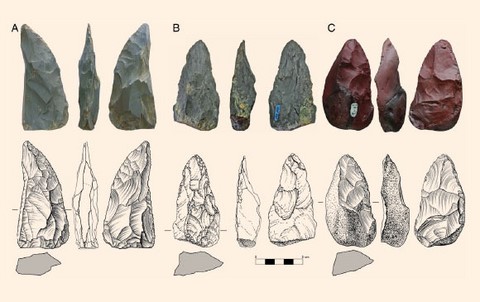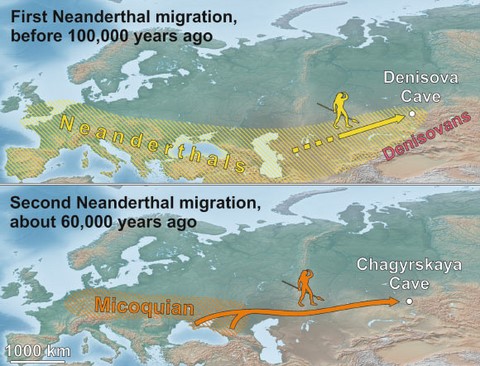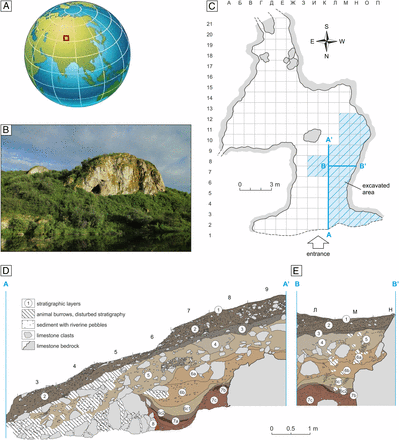Neanderthal News 2020 - Part IV. "Travel"
Homo sapiens Interbred with Various Neanderthal Populations, Study Says
Modern humans in Eurasia carry genetic material inherited from Altai Neanderthals, according to a study published in the journal Genetics. This is noteworthy because past research has shown that Neanderthals connected to a different location — the Vindija Cave in Croatia — have also contributed DNA to modern-day Eurasian populations.
“It’s not a single introgression of genetic material from Neanderthals,” said University at Buffalo’s Dr. Omer Gokcumen, senior author of the study. “It’s just this spider web of interactions that happen over and over again, where different ancient hominins are interacting with each other, and our paper is adding to this picture.” “This project will now add to an emerging chorus — we’ve been looking into this phenomenon for a couple of years, and there are a couple of papers that came out recently that deal with similar concepts.”
“The picture in my mind now is we have all these archaic hominin populations in Europe, in Asia, in Siberia, in Africa.” “For one reason or another, the ancestors of modern humans in Africa start expanding in population, and as they expand their range, they meet with these other hominins and absorb their DNA, if you will.” “We probably met different Neanderthal populations at different times in our expansion into other parts of the globe.”
Dr. Gokcumen and colleagues analyzed the DNA of hundreds of people of Eurasian ancestry.
The goal was to hunt for fragments of genetic material that may have been inherited from Neanderthals.
The researchers found that the Eurasian populations could trace some genetic material back to two different Neanderthal lineages: one represented by a Neanderthal whose remains were discovered in the Vindija cave in Croatia, and another represented by a Neanderthal whose remains were discovered in the Altai mountains.
They also discovered that the modern-day populations they studied also share genetic deletions — areas of DNA that are missing — with both the Vindija and Altai Neanderthal lineages.
The DNA of the Vindija and Altai Neanderthals, along with the modern human populations studied, were previously sequenced by different research teams.
“It seems like the story of human evolution is not so much like at tree with branches that just grow in different directions. It turns out that the branches have all these connections between them,” Dr. Gokcumen said. “We are figuring out these connections, which is really exciting. The story is not as neat as it was before. Every single ancient genome that is sequenced seems to create a completely new perspective in our understanding of human evolution, and every new genome that’s sequenced in the future may completely change the story again.”
Ozgur Taskent et al. Analysis of Haplotypic Variation and Deletion Polymorphisms Point to Multiple Archaic Introgression Events, Including from Altai Neanderthal Lineage. Genetics, published online March 31, 2020; doi: 10.1534/genetics.120.303167
This article is from sci-news.com
Neanderthals Entered Southern Siberia on Two Separate Occasions, Study Says
Neanderthals were once widespread across Europe and western Asia. They also penetrated into the Altai Mountains of southern Siberia, but the geographical origin of these populations and the timing of their dispersal remain elusive. Archaeologists excavating Chagyrskaya Cave in the Altai foothills have found 90,000 stone artifacts, numerous bone tools, 74 Neanderthal fossils, and animal and plant remains in 59,000- to 49,000-year-old deposits. The Chagyrskaya Neanderthals made distinctive stone tools that bear a striking similarity to Neanderthal artifacts from eastern Europe, whereas other Altai sites occupied by earlier Neanderthal populations lack such artifacts. This suggests at least two dispersals of Neanderthals into southern Siberia, with the likely ancestral homeland of the Chagyrskaya toolmakers located 3,000 to 4,000 km (1,900-2,500 miles) to the west.
“The most surprising discovery was how closely the Chagyrskaya stone tools resemble Micoquian tools from archaeological sites in central and eastern Europe,” said Dr. Kseniya Kolobova, a researcher in the Institute of Archaeology and Ethnography in Novosibirsk, Siberia.
Using a variety of statistical tests, Dr. Kolobova and her colleagues from Australia, Ukraine, Poland, Germany and Canada compared the distinctive stone tools found at Chagyrskaya Cave with those recovered from Micoquian sites in Europe and central Asia.
They identified the region between the Crimea and the northern Caucasus as the likely ancestral homeland of the Chagyrskaya toolmakers.

Stone artifacts from Chagyrskaya Cave: (A-C) photographs, line drawings, and cross-sectional profiles of three plano-convex bifacial tools diagnostic of Micoquian types. Scale bar – 5 cm. Image credit: Kolobova et al, doi: 10.1073/pnas.1918047117.
“This part of eastern Europe is 3,000 to 4,000 km from Chagyrskaya Cave, the equivalent of walking from Sydney to Perth or from New York to Los Angeles — a truly epic journey,” said Professor Richard ‘Bert’ Roberts, a geochronologist in the Centre for Archaeological Science at the University of Wollongong.
The analyses of animal and plant remains extracted from the Chagyrskaya Cave deposits showed that the Neanderthals were skilled at hunting bison and horses in the cold, dry and treeless environment, while microscopic study of the sediments yielded additional clues about the living conditions they had to endure.
“Neanderthals were supremely adapted to life on steppe and tundra-steppe landscapes, and could have reached the Altai Mountains from eastern Europe by going around the Caspian Sea and then east along the steppe belt,” said Dr. Maciej Krajcarz, a geoarchaeologist in the Institute of Geological Sciences in the Polish Academy of Sciences.

Early and later Neanderthal dispersals to southern Siberia. Image credit: Kseniya Kolobova / Maciej Krajcarz / Victor Chabai.
The new archaeological evidence indicates at least two separate migrations of Neanderthals into southern Siberia, and is independently supported by whole-genome studies of ancient DNA obtained from Neanderthal fossils.
The first migration occurred more than 100,000 years ago, blazing a trail to the nearby site of Denisova Cave — famous as the home of the enigmatic Denisovans, a sister group to Neanderthals, who also occupied the cave at times.
A more recent migration event — originating in eastern Europe possibly about 60,000 years ago — led to the arrival of Neanderthals at Chagysrkaya Cave, armed with their distinctive Micoquian toolkit.
DNA studies confirm a link between Neanderthals living in Europe and at Chagyrskaya Cave after 100,000 years ago.
Despite the geographic proximity of Chagyrskaya and Denisova Caves, the Chagyrskaya Neanderthal genome is more similar to those of European Neanderthals than it is to the 110,000 year-old Neanderthal from Denisova Cave.
“By combining these new insights from archaeology and genetics, we can start to piece together the intriguing story of the easternmost Neanderthals and the events that shaped the history of our ancient human relatives,” Dr. Kolobova said.

The results were published in the Proceedings of the National Academy of Sciences.
_____
Kseniya A. Kolobova et al. Archaeological evidence for two separate dispersals of Neanderthals into southern Siberia. PNAS, published online January 27, 2020; doi: 10.1073/pnas.1918047117
http://www.sci-news.com/archaeology/chagyrskaya-neanderthals-08059.html

